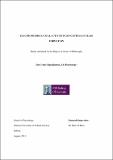| dc.description.abstract | The current project attempted to isolate patterns of electrophysiological activity that correlate with stimulus equivalence by examining the frequency spectra of simultaneous electroencephalographic (EEG) activity. This is the first recorded attempt to isolate the frequency correlates of stimulus equivalence.
Six experiments were conducted. Experiment 1.1 employed a linear matching-to-sample equivalence training protocol with easily recognizable (iconic) stimuli to train 6 3-member equivalence classes. Experiment 1.2 employed an identical protocol with the exception of the use of abstract images instead of iconic stimuli. In both experiments, approximately half of the participants displayed equivalence. EEG results from Study 1 were inconclusive but did indicate that delta activity in the midline and posterior regions was correlated to activity during conditional discrimination training and equivalence as well as overall alpha activity, when compared to baseline. The protocol was amended for Experiments 2.1 and 2.2. Participants were exposed to a set number of training and extinction trials rather than a preset mastery criterion. Second, the number of trials presented during equivalence testing was increased. Participants which failed to display equivalence were not re-exposed to the protocol. Experiment 2.1 employed a linear matching-to-sample training to train 3 3-member equivalence classes using iconic stimuli while Experiment 2.2 employed abstract stimuli. As in Experiment 1.1, approximately half of the participants in Experiment 2.1 displayed equivalence, but only one participant in Experiment 2.2 displayed equivalence. Experiment 2.1 in Study 2 replicated the baseline effects in the delta frequency but not in the alpha frequency. Differences were found between task stages in the Mid- and Right-Frontal regions in the gamma range, as well as baseline differences in the posterior regions In Experiments 3.1 and 3.2, was shortened further. Experiment 3.1 had a slightly lower yield than Experiments 1.1 and 2.1, and only one participant in Experiment 3.2 displayed equivalence. Differences in EEG power between baseline and training and testing stages were observed for all frequency bands, but no differences were found between different training and testing stages. Chapter 5 reports two sets of additional analyses. First, participants from Experiments 2.1 and 3.1 were pooled into one dataset to compare baseline differences in EEG activity. Significant differences between high and low performing participants in the gamma range at the Mid-Frontal, Mid-Central, Right-Central and Right-Posterior locations with high performing participants displaying higher gamma activity during baseline than low performing participants. Second, participants from Experiments 2.1, 2.2, 3.1 and 3.2 were pooled and their EEG activity during conditional discrimination training was compared based on stimulus types. Delta activity was more pronounced at the Mid-Posterior region in participants exposed to iconic stimuli than those exposed to abstract stimuli.
These experiments provide evidence that gamma activity during baseline may predict subsequent performance on a stimulus equivalence task, and that gamma activity in the posterior regions is more reactive to abstract stimuli than iconic stimuli. The current results indicate that any possible future physiological interventions to increase accuracy on equivalence tests should focus on posterior gamma activity. | en_US |


